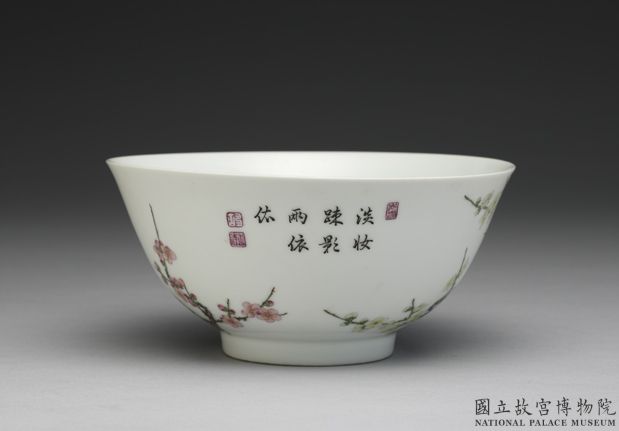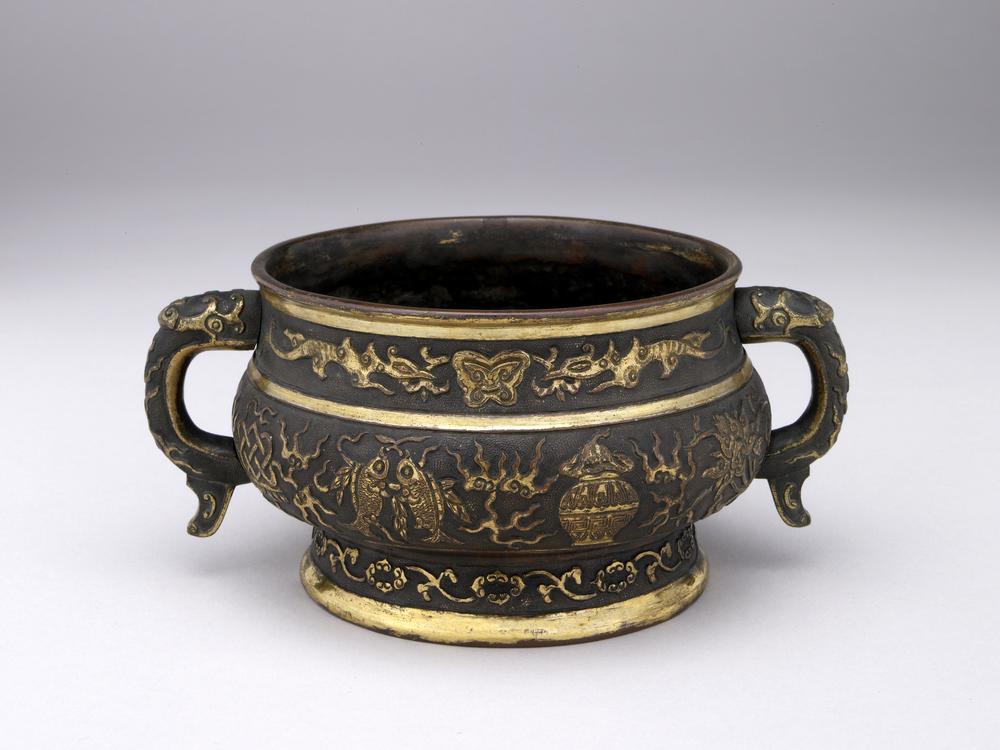Period:Ming dynasty Production date:1436-1464
Materials:porcelain
Technique:glazed, underglazed,
Subjects:eight treasures of buddhism canopy lotus
Dimensions:Diameter: 7 centimetres Height: 9 centimetres
Description:
Porcelain stem cup with underglaze blue decoration. This stem cup has a bowl with deep rounded sides, an everted rim, a straight stem shaft with a raised horizontal rib, flared stepped foot with a hollowed-out stem and an unglazed foot ring. It is painted sketchily in dark underglaze blue with a Tibetan/Sanskrit character in a medallion inside which reads ‘m’ and may be intended as part of a mantra. Outside it is spontaneously painted with five of the Buddhist Treasures, the endless knot, conch shell, parasol, canopy and lotus, among interlacing scrolls. The edges of the design, join of stem to bowl, rib and foot are all highlighted with double lines and the stem is further ornamented with elongated heart motifs half-filled with blue, half-filled with a check design. The piece is unmarked.
IMG
![图片[1]-stem cup BM-1940-1214.261-China Archive](https://chinaarchive.net/Ming dynasty/Ceramics/mid_00267321_001.jpg)
Comments:Harrison-Hall 2001:In contrast to the pure-white-bodied porcelains with fine underglaze blue decoration fired at the imperial kilns during the preceding Xuande era, this coarser stem cup was made at ‘min yao’ [commercial kilns] in the Jingdezhen area. Iron impurities in the glaze, dark cobalt blue and less refined clay are all characteristics of private-kiln-fired porcelains. Stem cups of this shape but with different decoration have been excavated at a kiln site in Hutian, Jingdezhen, from a Zhengtong to Tianshun context. This vigorous calligraphic style of decoration (‘xie hui’) was the most common type of underglaze painting mode at commercial kilns in the mid fifteenth century. A wine cup with an identical design of Buddhist emblems and interlacing scrolls has been excavated in the Jingdezhen area.Mantras are chants or spoken prayers which are an essential part of worship in Buddhism, invoking the spiritual realm. The Buddhist emblems and character from a mantra may suggest a ritual rather than daily function for the stem cup. During the Zhengtong reign period (1436-49) three imperial missions to Tibet took place and Tibetan lamaism was popular.
Materials:porcelain
Technique:glazed, underglazed,
Subjects:eight treasures of buddhism canopy lotus
Dimensions:Diameter: 7 centimetres Height: 9 centimetres
Description:
Porcelain stem cup with underglaze blue decoration. This stem cup has a bowl with deep rounded sides, an everted rim, a straight stem shaft with a raised horizontal rib, flared stepped foot with a hollowed-out stem and an unglazed foot ring. It is painted sketchily in dark underglaze blue with a Tibetan/Sanskrit character in a medallion inside which reads ‘m’ and may be intended as part of a mantra. Outside it is spontaneously painted with five of the Buddhist Treasures, the endless knot, conch shell, parasol, canopy and lotus, among interlacing scrolls. The edges of the design, join of stem to bowl, rib and foot are all highlighted with double lines and the stem is further ornamented with elongated heart motifs half-filled with blue, half-filled with a check design. The piece is unmarked.
IMG
![图片[1]-stem cup BM-1940-1214.261-China Archive](https://chinaarchive.net/Ming dynasty/Ceramics/mid_00267321_001.jpg)
Comments:Harrison-Hall 2001:In contrast to the pure-white-bodied porcelains with fine underglaze blue decoration fired at the imperial kilns during the preceding Xuande era, this coarser stem cup was made at ‘min yao’ [commercial kilns] in the Jingdezhen area. Iron impurities in the glaze, dark cobalt blue and less refined clay are all characteristics of private-kiln-fired porcelains. Stem cups of this shape but with different decoration have been excavated at a kiln site in Hutian, Jingdezhen, from a Zhengtong to Tianshun context. This vigorous calligraphic style of decoration (‘xie hui’) was the most common type of underglaze painting mode at commercial kilns in the mid fifteenth century. A wine cup with an identical design of Buddhist emblems and interlacing scrolls has been excavated in the Jingdezhen area.Mantras are chants or spoken prayers which are an essential part of worship in Buddhism, invoking the spiritual realm. The Buddhist emblems and character from a mantra may suggest a ritual rather than daily function for the stem cup. During the Zhengtong reign period (1436-49) three imperial missions to Tibet took place and Tibetan lamaism was popular.
© Copyright
The copyright of the article belongs to the author, please keep the original link for reprinting.
THE END





